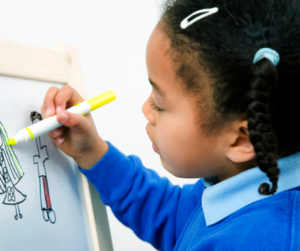Schools today are NOT teaching children to write. Instead, they are allowing children to figure out, on their own, how to make the letters. This leads to children drawing letters instead of writing them.
What’s the difference? And why does it matter?
 First, let’s talk about learning to draw. Did anyone teach you how to draw a stick figure? Probably not, but you can still do it. You could probably draw several if asked. However, because you are drawing, you might start the first one by making the circle for the head, and the second with the body. And the third time, you might start at the feet and work your way up. Each little stick man would be different. And each would take a different amount of time to draw, as you look for what is missing, add those things, and choose what line to make next.
First, let’s talk about learning to draw. Did anyone teach you how to draw a stick figure? Probably not, but you can still do it. You could probably draw several if asked. However, because you are drawing, you might start the first one by making the circle for the head, and the second with the body. And the third time, you might start at the feet and work your way up. Each little stick man would be different. And each would take a different amount of time to draw, as you look for what is missing, add those things, and choose what line to make next.
Many children draw their letters this way. When they make B, for example, sometimes the lines start at the top of the letter. Sometimes they start at the bottom. They may make the top curve first, then the lower, but next time they make the lower curve first, then realize they still need one at the top. They draw the letter they see in their mind, fresh each time.
This is exhausting. Is it legible? Maybe, but it is slow and laborious and makes it hard to write a long passage when you need to stop and think of how to draw each letter. Think of it as needing to draw a long series of stick men one by one, each with a different hat to tell a story. Each time you have to think about whether the figure’s arms should be up, down, or sideways. You have to decide what expression it should be wearing.
How is writing different?
Real handwriting involves learning to make the letter with a few clean, deliberate strokes, the same way every time. Once you have this skill, you don’t have to think of how to form the letters. You know how to make them not only in your mind but from muscle memory. When you can write well, you can write neatly with your eyes closed. Getting in the rhythm of always making your letters the same way, neat and clean, is a long slow process. In the past, when students had beautiful handwriting, penmanship was a class that was taught right up through high school, because it is not a skill that develops easily by doing a few quick worksheets when a child is 5.
 For some students, the step into real writing is easier to take with writing in cursive than printing. When you print, the place where the letter should start and stop can feel subjective. As a result, many adults DO form at least a few letters differently than our handwriting worksheets told us to.
For some students, the step into real writing is easier to take with writing in cursive than printing. When you print, the place where the letter should start and stop can feel subjective. As a result, many adults DO form at least a few letters differently than our handwriting worksheets told us to.
However, with cursive, the lowercase letters can all be started from the bottom, as part of a connection line, and those that can also start from the top, like c, have a very clear starting place. If you try to start most cursive letters from the wrong place, you just can’t make them at all. An essential part of cursive writing is that you actually have to write every letter and follow the correct path, or it just won’t be that letter. You really can’t draw a cursive letter pattern. You have to write cursive letters.
So how do I recommend we teach writing? SLOW DOWN!
 This is what we need to do. Preschool and kindergarten-age children don’t actually have the coordination, mentally or physically, to write. They only possess the ability to draw. So we need to stop and teach them to draw. Teach them to draw shapes, people, houses, and flowers. Let them develop those fine motor skills and a good pencil grip that will lead to good handwriting later on.
This is what we need to do. Preschool and kindergarten-age children don’t actually have the coordination, mentally or physically, to write. They only possess the ability to draw. So we need to stop and teach them to draw. Teach them to draw shapes, people, houses, and flowers. Let them develop those fine motor skills and a good pencil grip that will lead to good handwriting later on.
The next step I would recommend is to teach letter writing slowly. Start with capital, printed letters. Why? Because they are the easiest to form, stroke-wise, a child can most easily start to create legible words with a set of all capitals. This will give the child the ability to put their name on things (the best part of writing according to most small children) and start to write short words.
What about good grammar?
Quite honestly, it can wait. Your 6-year-old doesn’t need to write their thesis.
We’ve quit seeing skills as having a progression and have started asking kids to do all of the skills of reading and writing as fast as possible. We need to slow down. Let kids really learn how to form letters, slowly. Let them write in all capitals until they are ready to learn to write in lowercase or in cursive. Trust that if we wait to teach written grammar until after a child is able to speak with good grammar and tell a story orally, it will be easier, faster, and less stressful. Our goals should be to bring our children along as slowly as they need to go to really learn to write each letter before we start asking them to write sentences.
Remember what the Tortoise and the Hare taught us.
 The reason so many children today have such horrible handwriting is that they are drawing those letters as fast as they can. They are struggling to keep up with a demand to use basic skills they don’t actually have because no one taught them. Eventually, many of those children form a habit of how to make the letters, a repetition of starting it from the bottom, the middle, or the side, that helps them keep up. Some of them learn to create more legible letters on their own, and others don’t. We judge the ones who don’t as lazy when in truth, they figured out what to do in the best way they could. Much like a child who doggie paddles through swim class, they are doing the best they can with what they’ve got.
The reason so many children today have such horrible handwriting is that they are drawing those letters as fast as they can. They are struggling to keep up with a demand to use basic skills they don’t actually have because no one taught them. Eventually, many of those children form a habit of how to make the letters, a repetition of starting it from the bottom, the middle, or the side, that helps them keep up. Some of them learn to create more legible letters on their own, and others don’t. We judge the ones who don’t as lazy when in truth, they figured out what to do in the best way they could. Much like a child who doggie paddles through swim class, they are doing the best they can with what they’ve got.
If you are homeschooling and able to ignore the pace the schools set for learning to read and write, I highly recommend it. Take time to teach them how to first draw their shapes, then write in capital letters. Go slow, and keep in mind the goal of learning to really write, rather than rushing through the letters so that you can get to “real writing.”
Slow down, and realize that your child doesn’t need to write in paragraphs in first grade. There is no reason to push that skill. You can do it slow and steady and still get your child where they need to go with writing. They will be better off for it.
P.S. If you would like to start handwriting in a slow and steady way with your child, check out our Orange Level program, Foundations & Fundamentals. This curriculum will give you the tools to teach your child each uppercase letter in a way that forms the most brain connections possible. You will experience the letters in multi-sensory ways and use our new handwriting tools and worksheets which are designed by an occupational therapist. The program also gives you the ability to teach phonics alongside handwriting so that your child understands that writing and reading are connected.





0 Comments